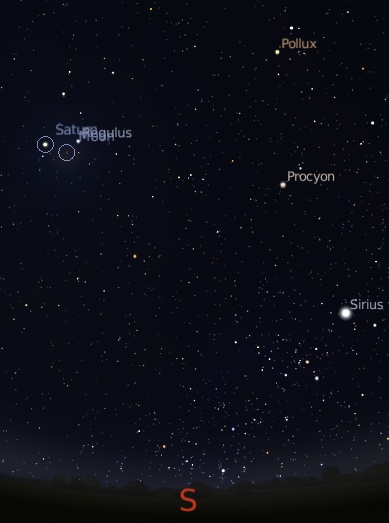A lunar eclipse

The eclipse near totality at 22:43 20 Feb 2008.
I lucked out when Libby sent me a txt the evening of the lunar eclipse on Feb. 20, and the weather cleared in time. The conditions were excellent, and although I don’t really have the right sort of camera equipment — a tripod would have been nice! — I managed a few decent pictures with patience and a lot of bracketing.
The reddish color is fairly accurate, a result of sunlight passing through the Earth’s atmosphere. The depth of color is unpredictable: when I was about 7 I recall my mother waking and hustling me outside late at night to see a seemingly huge blood-red eclipse. Fortunately I was then at my grandmother’s house in the country and the spectacle was unforgettable.
I wondered while shooting this eclipse about the bright “stars” nearby. I included them in several photos, not knowing what they were. I later heard learned Saturn (a relatively dim magnitude 0.87 on that night) and the star Regulus (magnitude 1.35, about two-thirds as bright as Saturn) had been close by.
(The magnitude scale is logarithmic. Sirius at -1.42 is brightest, almost nine times brighter than Saturn was. More on bright stars: E.g., “Sirius comes from the Greek word Seirius, meaning, “searing” or “scorching.”” I checked the Oxford dictionary, which attributes the name to Sirius rising with the Sun in the heat of summer … hmm … and I thought Sirius meant “dog”!)
Because I was bracing the camera (a Pentax K10D dSLR with a 80-200 zoom lens, shooting in RAW mode) against a truck, and because I know almost nothing about astronomy, I had no idea from the pictures which way was up or south or what the other objects were. So … I used the cross-platform public domain (yay!) Stellarium to plot the sky for the date and time at my location. You can see the Moon, Saturn, and Regulus clustered at the upper left.

Detail of Stellarium plot for Southern sky on Feb. 20 around 10 pm.
The magnified plot inset below is a little rough (the commercial package Starry Night is more polished), but I’m impressed by its effort to shade the (oversized) moon. I think the result is accurate, but please consult other sources before planning your interstellar travel.

Detail from Stellarium plot inset (red circle) on photograph.
Note tiny tails on the stars. Apparently I moved the camera at the beginning or end of the 1.5-second exposure and the camera was sensitive enough to catch it. Hey, it was near freezing! But I think the cold improved the atmospheric conditions.
Neat web resources, huh? The nicest thing is it didn’t take much time, except for trying to get that red circle right.
Now, growing up in LA I probably would have figured the moon looked funny that night because of smog. 🙂
–ad
My current desktop picture:

Leave a comment